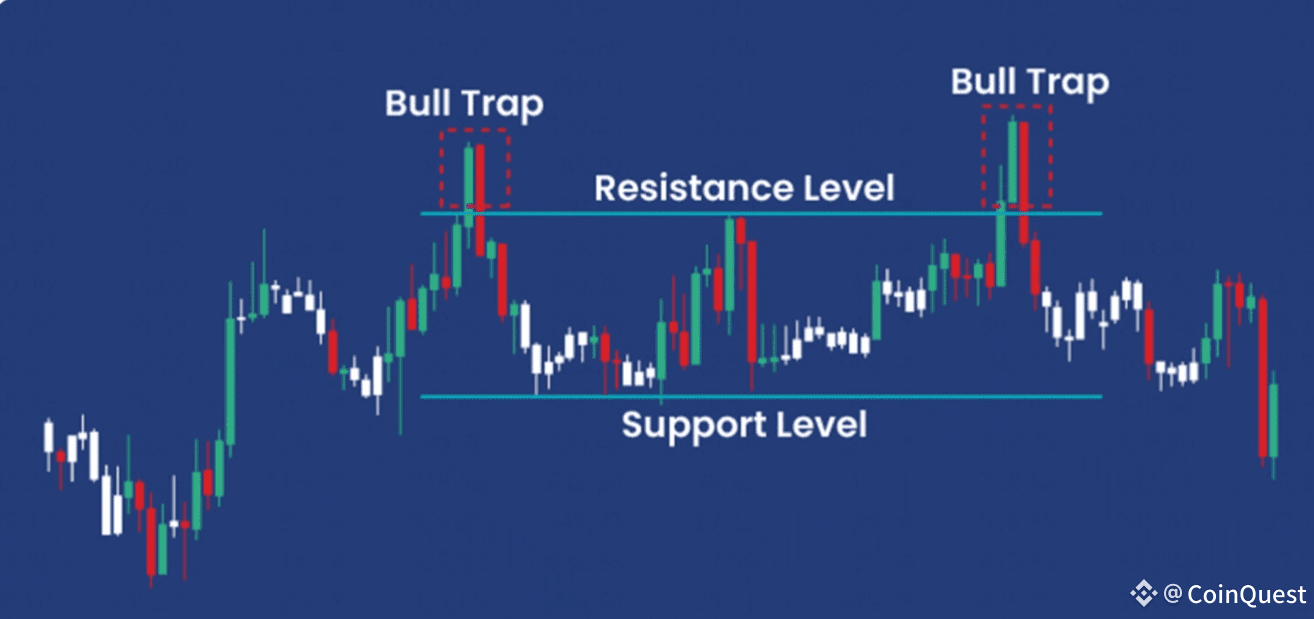In crypto, things move fast — sometimes too fast. A perfect setup can flip into a trap within minutes, leaving traders chasing fake breakouts and sudden reversals. Knowing how to read funding, open interest, and volume data can help you avoid those bull and bear traps before they take your capital.
Key Takeaways
Wait for confirmation, not hope. Always let a higher-timeframe candle close and confirm the retest before increasing size.
Watch leverage signals. Extreme funding plus rising open interest (OI) near key levels often hints at traps forming in the opposite direction.
Don’t trust thin liquidity. Off-hours trading, spoof orders, or token unlocks can create fake breaks that reverse just as quickly.
Respect liquidations. Once forced selling or buying clears, sharp snapbacks often follow — marking real exhaustion.
Why Crypto Is a Trap-Heavy Market
Crypto trades around the clock, with much of its activity driven by high-leverage perpetual futures. This 24/7 setup means even small order imbalances can move price violently — especially when liquidity is thin.
Bull traps happen when price briefly breaks above resistance, inviting buyers in before reversing sharply lower. Bear traps work the opposite way: a quick drop below support that snaps right back up, squeezing shorts.
Weekends and off-hours make these setups even more common. Liquidity dries up, market makers widen spreads, and a single headline can push price past a key level before balance returns.
Funding rates and open interest often tell the real story. When funding turns extremely positive or negative and OI builds near a key zone, the market is leaning too far in one direction — and that’s when traps form.
Bull Traps: How to Recognize False Breakouts
A bull trap typically appears when price breaks above resistance but fails to follow through. The move looks real at first, but volume stays weak, and soon after, price closes back within the prior range — leaving late buyers stuck.
Leverage data can expose this early. If funding spikes positive (longs paying shorts) and open interest rises near resistance, long positions are getting crowded — perfect conditions for a squeeze downward.
To confirm a real breakout, wait for:
1. A four-hour or daily close above resistance.
2. A successful retest of that level holding as new support.
3. Strong volume on the breakout, followed by healthy volume during the retest.
If any of these signals are missing, treat the move as suspect. Crowded long setups at key highs often turn into bull traps once momentum fades.
Bear Traps: The Reversal Below Support
A bear trap looks like breakdown at first glance — price dips below a widely watched support zone, shorts pile in, and then the market rips back higher.
The early signs are almost the inverse of a bull trap. When funding turns sharply negative and OI jumps lower into the dip, shorts are overcrowding. That imbalance often leads to a quick reversal once forced sellers are flushed out.
Confirmation comes from:
A close back above support on the four-hour or daily timeframe.
A higher low forming after reclaiming that level.
Volume and OI stabilizing or building after the bounce.
When those align, a squeeze higher becomes likely — catching late shorts off guard.
Leverage Fingerprints: Funding, OI, and Liquidations
Funding rates: These periodic payments between longs and shorts keep perpetual prices aligned with spot. If funding is strongly positive, the market’s crowded long; strongly negative, it’s crowded short. Extreme readings tend to mark turning points.
Open Interest (OI): Rising OI near key levels means more leverage at risk — more potential fuel for a squeeze. A sudden flush in OI during a fast move usually means forced exits or liquidations. If price quickly reclaims the level and OI rebuilds, that’s classic trap behavior.
Liquidation Cascades: Leveraged positions can be closed automatically when margins fail. When clustered liquidations trigger, moves accelerate — then reverse just as fast once leverage is cleared. This is the signature “bull or bear trap” pattern seen repeatedly in Bitcoin (BTC) and top altcoins.
When “Breakouts” Aren’t Real
Thin order books often make fake moves easier to create. During weekends or low-volume sessions, liquidity shrinks, spreads widen, and small trades can move markets far more than usual.
Watch for spoof orders — large bids or asks that vanish before being filled, creating a false sense of pressure. These tactics, while illegal in regulated markets, still appear on some crypto exchanges.
Catalyst events can distort price too. Token listings, unlocks, or news headlines can cause short-term breaks that fade as liquidity returns. If price quickly reclaims the “broken” level with improving participation, it was likely a trap.
A Simple Checklist to Avoid Market Traps
Before entering any breakout or breakdown, run this list:
1. Retest and hold. False moves fail on first retest. Wait for confirmation.
2. Participation. Check volume — strong moves need strong flow.
3. Derivatives context. Extreme funding or OI near levels = trap potential.
4. Liquidation clues. After a cascade, avoid chasing the wick.
5. Timing. Off-hours and weekends carry more risk.
6. Higher timeframe proof. Four-hour or daily close + solid retest = real move.
7. Defined invalidation. Know exactly where you’re wrong before sizing up.
If a setup doesn’t meet these standards — skip it. There’s always another opportunity.
Final Thoughts
Crypto’s 24/7 structure makes it exciting — but also ruthless. Fake breaks and forced squeezes are part of the game. By watching funding, open interest, and participation closely, you can tell when the crowd’s leaning too far — and step aside before the trap snaps shut.
The best traders aren’t the fastest; they’re the most patient. Wait for confirmation. Let the market prove itself — not the other way around.


